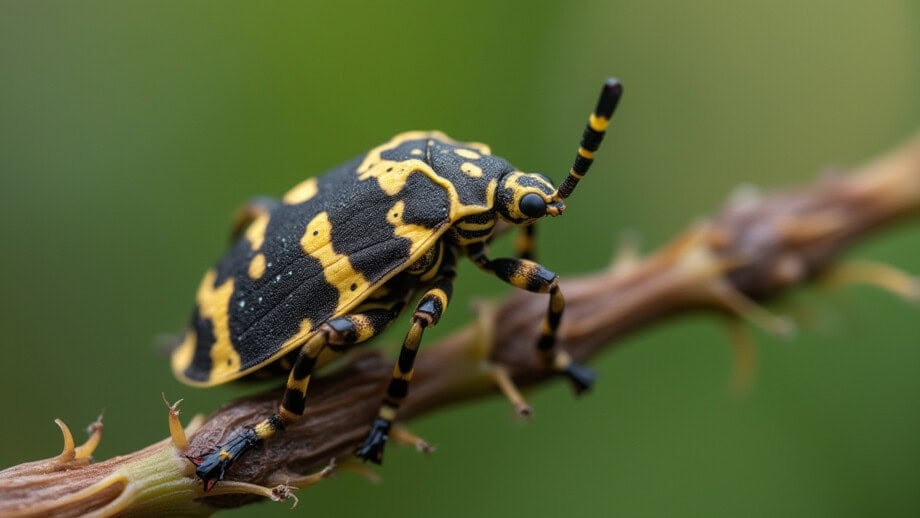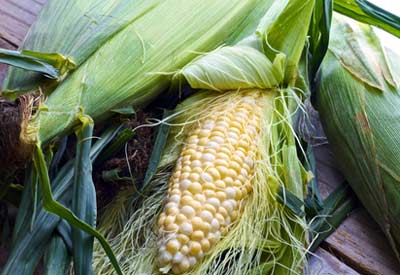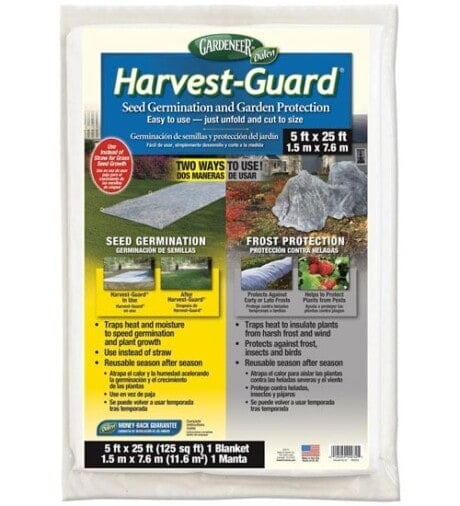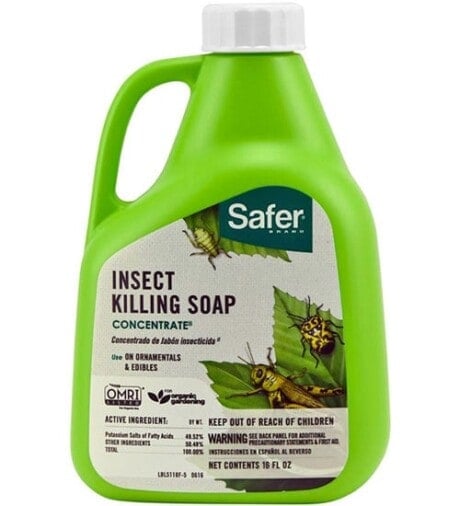How to Identify and Get Rid of Stink Bugs (BMSB)

There are hundreds (and hundreds) of different types of Stink Bugs. But it’s the Asian newcomers, first found in Allentown, Pennsylvania in 1998, that get all the attention.
That’s because Stink Bugs quickly spread across the country. And they’re infamous for swarming inside the walls and other places in one’s house.
But they’re not alone. Stink bugs native to North America were causing problems for growers and releasing strange odors long before the non-native types invaded. Most are sap suckers that damage and weaken plants.
It can be a nuisance pest in homes when it seeks overwintering sites in the fall and has a strong, unpleasant odor.
Not picky, the pests feed on fruits, vegetables, and vegetation. They’re present, in greater or lesser numbers, all through the growing season.
Read on to learn everything you need to learn about them, including how to get rid of stink bugs!
What is a Stink Bug?
The brown marmorated stink bug (BMSB), Halyomorpha halys, is considered an invasive species or a foreign pest because it was introduced to the United States from East Asia in the mid-1990s.
It is also known as the yellow-brown stink bug or the East Asian stink bug. The bug was discovered in the United States in the fall of 1996 in Allentown, Pennsylvania, but it was not recognized or identified until September 2001.
It rapidly spread east to New Jersey, then to Virginia by 2004, and has now reached the southern border of North Carolina.
Currently, the brown marmorated stink bug is most prevalent in the mid-Atlanta region, but it has been documented in 44 states and the District of Columbia.
It was discovered in Oregon in 2004 and has since spread throughout the state and into Washington.
In 2006, a reproducing population was discovered for the first time in Pasadena and San Marino (Los Angeles County), and it has since been discovered in numerous other areas of California.
Large reproducing populations were found in Yuba City and Sacramento in 2013.
As BMSB spreads along the West Coast, it will most likely be found first in urban areas. The bug is native to China, Japan, Korea, and Taiwan.
The stink bug got its name from the smell it gives off when it is moved or squashed. These traits are shared by a wide variety of insects, including some ant, beetle, and bug species.
How to Identify Stink Bugs?
Adult Stink Bugs are shield-shaped insects measuring 1/2 inches in length from the true bug order (Hemiptera). The family Pentatomidae to which these garden pests belong contains some 900 genera and over 4700 species.
They have long piercing-sucking mouthparts held under the body between the legs, and when disturbed or crushed, they frequently emit an odor.
The term “brown marmorated stink bug” describes the insect’s exterior, which is marmorated (marble-patterned).
Nymphs have dark reddish eyes and a yellowish-red abdomen that is striped with black. The nymphs have black legs and antennae with white bands.
Brown Marmorated Stink Bug eggs are light green in color and are frequently laid on the underside of leaves. They are elliptical in shape (1.6 x 1.3 mm) and frequently laid in masses of around 28 eggs.
More common types include brown, green, rice, Southern and dusky stink bugs.
Other family types include shield bugs and chust bugs. Most are identified by their shield, the hardened part of their thorax that gives them the appearance of being armored.
Coloring can be solid or mottled and can range from brown and black to bright green with red or orange trim.
The widely distributed Conchuela stink bug can be black in southern states, green in northern states, and a strange combination of the two in the area between. Conchuela feeds on fruits and crops including grapes, peas, and tomatoes. In dry regions, it feeds on sage, yucca, and prickly pear.

Are Stink Bugs Harmful?
The characteristic odor — some describe it as the smell of rotted cilantro — comes from glands located on the thorax. It’s released as a defensive mechanism and can be a nuisance for those working in their gardens or, especially, if found in clusters, on the ground, or on the sides of trees.
Not all stink bugs are harmful. Predators, including the Florida predatory stink bug, feed voraciously on sap-sucking insects.
Predators aren’t easily distinguished from harmful types unless you’re familiar with the various coloring of different species. Harmful, vegetative feeders have a long, needle-like proboscis.
Predators have a shorter, bulkier proboscis, and feed on a variety of insect pests. Again, like their sap-sucking cousins, they’re not picky.
New varieties of pests commonly known as stink bugs continue to come to our shores. The painted bug or Bagrada bug of Southern Europe and Africa, a major pest of brassica crops, was first collected in California in 2008 and has since spread to Arizona and Texas. Euschistus quadrator, a pest that thrives on genetically engineered corn has spread across the south since moving up from Mexico in the 1970s.
The sheer variety of stink bugs is on beautiful display at naturalist-photographer Bev Wigney’s gallery.
Life Cycle of a Stink Bug
Adults overwinter beneath brush, under tree bark, in wood piles, and against the corners of buildings.
Some, like the brown marmorated stink bug (BMSB), will gather inside walls and window sills if they can find a way in. From wherever they hide, they emerge early in spring and begin to feed.
When conditions are right they mate. Like crickets, the stink bugs ‘chirp’ by rubbing their legs together in an attempt to attract mates.
They also release a bug-arousing pheromone scent, different than the offensive scent that gives them their name.
The female lays distinctive clusters of eggs — as many as 150 in a cluster — on plant leaves, tree branches, or on houses, frequently on the bottom of clapboard siding. The clusters can be yellow, brown, white, or pink, usually deepening in color as the nymph develops.
Breeding can continue through the season, allowing for various generations to be at different stages of development through the summer.
Populations increase as they overlap, resulting in higher and higher numbers just as many crops move towards maturity as the season progresses.
Nymph stages resemble adult stages but with significant size and color differences. Adult colors appear as the nymph passes through various (often five) instars. Nymphs are usually flightless.
In fall, as food sources dry up and disappear, the adults begin to gather in a place to overwinter and repeat the cycle. They sometimes will emerge during spells of warm autumn or winter weather but often aren’t seen again until spring.
Virginia Cooperative Extension’s Integrated Pest Management program has an excellent field guide with photos that identify eggs, nymphs, and adult stages of various stink bug types.
Signs of a Stink Bug Infestation
Stink bugs are frequently found inside homes during the late summer and fall months when temperatures outside begin to fall.
A large number of live or dead stink bugs is an indication of an infestation. Stink bugs will appear on the sunny sides of houses because that’s where they warm up.
Growers frequently identify an infestation by the crop damage it causes. To understand this, let’s figure out what type of damage stink bugs cause.
Damage Caused by Stink Bug
Stink bugs are all appetite and will feed from whatever plants are convenient. They prefer the fleshy part of fruits but can adapt to conditions as plants in late season begin to lose moisture.
Brown marmorated stink bugs are a serious pest of many fruits and fruiting vegetable crops because they primarily damage the fruit.
BMSB is said to feed on over 100 host plants in Asia, including tree fruit, vegetables, shade trees, and leguminous crops.
In the mid-Atlantic, apple, pear, peach, lima bean, pepper, sweet corn, tomato, and soybean are the crops that are most affected.
Raspberry, blueberry, grape, hazelnut, pecan, cucumber, and pole and bush bean are among the other crop hosts identified.
BMSB can grow to very large populations, and since a single bug can feed on a variety of fruit sources, losses may be substantial.
Fruit and vegetables lose their marketability due to pockmarks and distortions caused by adults and nymphs injecting tissue-destructing enzymes and sucking juice from fruit and seeds.
In addition to the pin-prick piercing which results in blemishes, the insects also inject a digestive enzyme that causes discoloration as it spreads through the plant’s vascular system.
Given the choice, the pests will always choose fruit over foliage, they are opportunist and will feed on what’s available, including seeds and stems.
Damage to cabbage and other leafy crops can be seen in gray and beige blotches. Corn attacked by the pests will have dark spots on stalks and, more likely, deformed ears with missing kernels.
Fruit skins will show browning where the bugs have fed and tomatoes show a darkened bruise around the spot where the pest has inserted its proboscis.
Damaged flesh beneath the skin becomes hard and pithy. They can also feed on buds, flowering structures, leaves, and stems, as well as feeding through the bark of young tree branches and trunks.
Some types are known to exist in arid climates on woody plants and even cacti, yet prefer commercially raised, irrigated crops that are grown in such regions.
Although damage to crops caused by stink bugs is often cosmetic but also leads to early decay and spoilage.
How to Get Rid of Stink Bugs
Keep Your Yard Tidy
Keep areas around gardens clear of tall grass, brambles, downed limbs, and other natural litter to deny a place to overwinter.
Seal Cracks
Good silicone or silicone-latex caulk should be used to seal cracks around windows, doors, siding, utility pipes, behind chimneys, under wood fascia, and other openings.
A vacuum cleaner can be used to remove both live and dead stink bugs from interior areas. However, the vacuum may pick up the smell of stink bugs for a short period of time. If a large number of them are crushed or sucked into a vacuum cleaner, their odor can be quite noticeable.
Use a Good Organic Practice
Using good organic practice — soil building, encouraging beneficial microbes and other soil life, maintaining habitat for beneficial organisms including birds; balanced nutrient and moisture management, and applications of compost — helps plants resist damage caused by stink bugs.
Try Traps to Detect
Use sticky traps and tape to detect the presence of pests.
Use Row Covers
When stink bugs are expected, especially as crops approach harvest, use row covers to prevent them from gaining access. Collect any bugs that land on the covers and drown them in a can with water and some soap.
Utilize Beneficial Insects
A number of naturally occurring predatory insects will destroy Pentatomidae in stages from egg and larvae to adult. Keep areas surrounding the garden free of pesticides to assure these beneficial insects can play a role in your Integrated Pest Management (IPM) program.
The parasitic wasp Trissolcus basalis, which inserts its eggs into the pest’s eggs, has been shown to be effective against the Southern green stink bug.
California has released the wasps in some tomato growing areas in an effort to reduce pest damage. Studies after the release found that 80% of all target egg masses had been visited by the wasp and that 87% of the eggs in each mass had been impregnated.
Other beneficial insects known to predate on Pentatomidae during various stages of the pest’s development include ladybugs, lacewing and the minute pirate bug.
Use Kaolin Clay
Kaolin clay, a harmless mineral, has been shown to suppress pest activity. Sold in a modified form as Surround WP Crop Protectant, it repels the bugs by attaching itself to their bodies, agitating them and causing them to flee.
The non-toxic kaolin clay also coats leaves and fruit with a fine film that keeps the pests from feeding. (The film has been shown to actually increase photosynthesis and encourage healthy growth in trees and other plants.)
Spray kaolin clay periodically throughout the season in places where stink bugs do heavy damage.
Try Insecticidal Soaps and Neem Oil
Insecticidal soaps and neem oil are also effective against stink bugs, especially early in the season.
Make a DIY Stink Bug Trap
Finding pests in your home? Fill an aluminum turkey pan, preferably recycled, with an inch or so of water and stir in a little dish detergent. Shine a lamp (like a desk lamp) on the surface and leave it on overnight. The light attracts the bugs who land in the water and are held by the detergent. From there, you know what to do.

















